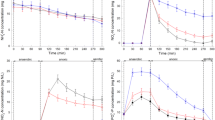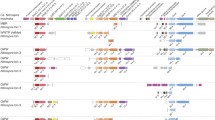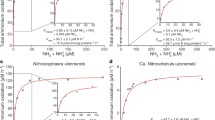Abstract
Cells of the obligately lithotrophic species Nitrosomonas europaea and Nitrosomonas eutropha were able to nitrify and denitrify at the same time when grown under oxygen limitation. In addition to oxygen, nitrite was used as an electron acceptor. The simultaneous nitrification and denitrification resulted in significant formation of the gaseous N-compounds nitrous oxide and dinitrogen, causing significant nitrogen loss. In mixed cultures of N. europaea and various chemoorganotrophic bacteria, the nitrogen loss was strongly influenced by the partners growing under oxygen limitation. Under anoxic conditions, pure cultures of N. eutropha were able to denitrify with molecular hydrogen as electron donor and nitrite as the only electron acceptor in a sulfide-reduced complex medium. The increase of cell numbers was directly coupled to nitrite reduction. Nitrous oxide and dinitrogen were the only detectable end products. In pure cultures of N. eutropha and mixed cultures of N. eutropha and Enterobacter aerogenes, ammonium and nitrite disappeared slowly at a molar ratio of about one when oxygen was absent. However, under these conditions cell growth was not measurable.
Similar content being viewed by others
Explore related subjects
Discover the latest articles and news from researchers in related subjects, suggested using machine learning.References
Abeliovich A (1987) Nitrifying bacteria in wastewater reservoirs. Appl Environ Microbiol 53:754–760
Abeliovich A, Vonshak A (1992) Anaerobic metabolism of Nitrosomonas europaea. Arch Microbiol 158:267–270
Bock E, Heinrich G (1969) Morphologische und physiologische Untersuchungen an Zellen von Nitrobacter winogradskyi Buch. Arch Mikrobiol 69:149–159
Bock E, Wilderer PA, Freitag A (1988) Growth of Nitrobacter in the absence of dissolved oxygen. Water Res 22:245–250
Broda E (1977) Two kinds of lithotrophs missing in nature. Z Allg Mikrobiol 17:491–493
Fiadeiro M, Solórzano L, Strickland JDH (1967) Hydroxylamine in seawater. Limnol Oceanograph 12:555–556
Hooper AB (1968) A nitrite-reducing enzyme from Nitrosomonas europaea. Preliminary characterisation with hydroxylamine as electron donor. Biochim Biophys Acta 162:49–65
Klapwijk A (1985) Application of denitrification in the wastewater treatment. In: Golterman HL (ed) Denitrification in the nitrogen cycle, Nato conference series 1, vol 9. Plenum Press, New York, pp 241–255
Koops HP, Böttcher B, Möller UC, Pommerening-Röser A, Stehr G (1991) Classification of eight new species of ammonia-oxidizing bacteria: Nitrosomonas communis sp. nov., Nitrosomonas ureae sp. nov., Nitrosomonas aestuarii sp. nov., Nitrosomonas marina sp. nov., Nitrosomonas nitrosa sp. nov., Nitrosomonas eutropha sp. nov., Nitrosomonas oligotropha sp. nov., and Nitrosomonas halophila sp. nov.. J Gen Microbiol 137:1689–1699
Miller DJ, Nicholas DJD (1985) Characterization of a soluble cytochrome oxidase/nitrite reductase of Nitrosomonas europaea. J Gen Microbiol 131:2851–2854
Poth M (1986) Dinitrogen production from nitrite by a Nitrosomonas isolate. Appl Environ Microbiol 52:957–959
Poth M, Focht DD (1985) 15N Kinetic analysis of N2O production by Nitrosomonas europaea: an examination of nitrifier denitrification. Appl Environ Microbiol 49:1134–1141
Reh M, Schlegel HG (1981) Hydrogen autotrophy as a transferable genetic character of Nocardia opaca 1b. J Gen Microbiol 126: 327–336
Robertson LA, Niel EWJ van, Torremans RAM, Kuenen JG (1988) Simultaneous nitrification and denitrification in aerobic chemostat cultures of Thiosphaera pantotropha. Appl Environ Microbiol 54:2812–2818
Stüven R, Vollmer M, Bock E (1992) The impact of organic matter on nitric oxide formation by Nitrosomonas europaea. Arch Microbiol 158:439–443
Whitman WB, Bowen TL, Boone DR (1992) The methanogenic bacteria. In: Balows A, Trüper HG, Dworkin M, Harder W, Schleifer KH (eds) The prokaryotes, 2nd edn, vol 1. Springer, Berlin Heidelberg New York, pp 719–767
Author information
Authors and Affiliations
Rights and permissions
About this article
Cite this article
Bock, E., Schmidt, I., Stüven, R. et al. Nitrogen loss caused by denitrifying Nitrosomonas cells using ammonium or hydrogen as electron donors and nitrite as electron acceptor. Arch. Microbiol. 163, 16–20 (1995). https://doi.org/10.1007/BF00262198
Received:
Accepted:
Issue Date:
DOI: https://doi.org/10.1007/BF00262198




